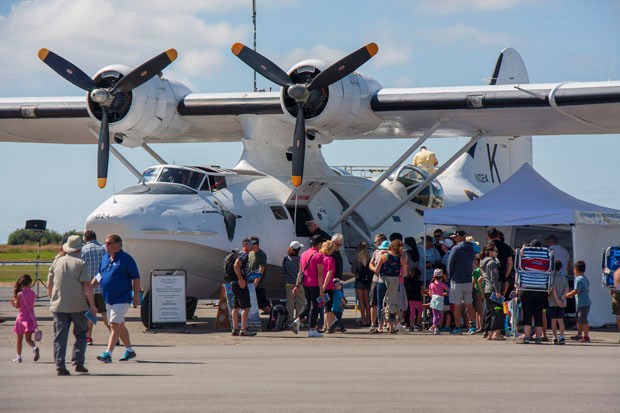In addition to the thrills in the sky, there will be plenty to see on the ground too as a number of vintage aircraft will be on display at this year’s Boundary Bay Airshow.
Here’s a look at some of what you will see:
The Erickson Collection Aircraft (at the show courtesy of sponsorship from Ocean Trailer)
P-40 Kitthawk
The Curtiss P-40 was a development of the radial engined P-36/Hawk 75. The prototype XP-40 was a converted P-36A with the R-1830 replaced with an Allison V-1710-19 liquid cooled V-12. First flown in October 1938, the P-40 was evaluated at Wright Field in May 1939 resulting in an order for 524 aircraft.
More than 13,700 P-40s had been built by the time production ended in December 1944. Although the P-40 did not have the best performance of its contemporaries, it did have a reputation as a rugged aircraft and it was available when needed.
The P-40 is most famous as the aircraft of General Claire Chennault’s American Volunteer Group – the Flying Tigers.
P-47 Thunderbolt
Republic Aviation’s P-47 Thunderbolt was the biggest and heaviest armed single engine American fighter of the Second World War. Its sturdy construction and eight 50-caliber machine guns made it equally adaptive as a ground support aircraft or as a bomber escort fighter. P-47s often demonstrated their ruggedness and dependability by returning home with combat damage that would doom any other production fighter.
The early P-47 couldn’t match the overall performance of the German fighters it faced in combat, but it could, because of its massive weight, out dive any airplane in the sky.
The P-47 saw action in every theatre proving itself to be a devastating low-level ground attack aircraft and versatile enough to be an effective high altitude escort fighter as well. With its bulky shape, the Jug was a monster of a machine, yet it was fast and maneuverable.
FM-2 Wildcat
The Grumman Wildcat, first of the Grumman “Cats,” marked the U.S. Navy’s transition from biplanes to the modern era of aircraft carrier borne seapower.
The September 1937 prototype was a radical redesign of an earlier Grumman biplane, the F3F. In 1939, an improved version of the aircraft, powered by a supercharged Pratt & Whitney Twin Wasp, 1,200 hp. radial engine, performed well and soon went into production at the Grumman plant in Bethpage, Long Island.
The Wildcat first became operational with the British Royal Navy, where it was named the Martlet. The British acquired 120 of the aircraft originally ordered by France and Greece, and with additional British orders, the Martlet served the Royal Navy well in the Atlantic and Mediterranean. The Wildcat first saw combat with the U.S. Navy and Marine Corps aviators when the Japanese attacked Pearl Harbor on7 December 1941.
Two interesting features of the Wildcat are wings that fold back along the fuselage to allow for easier carrier storage and the manually operated landing gear. A pilot had to crank a cockpit-mounted wheel 29 times to raise or lower the apparatus.



